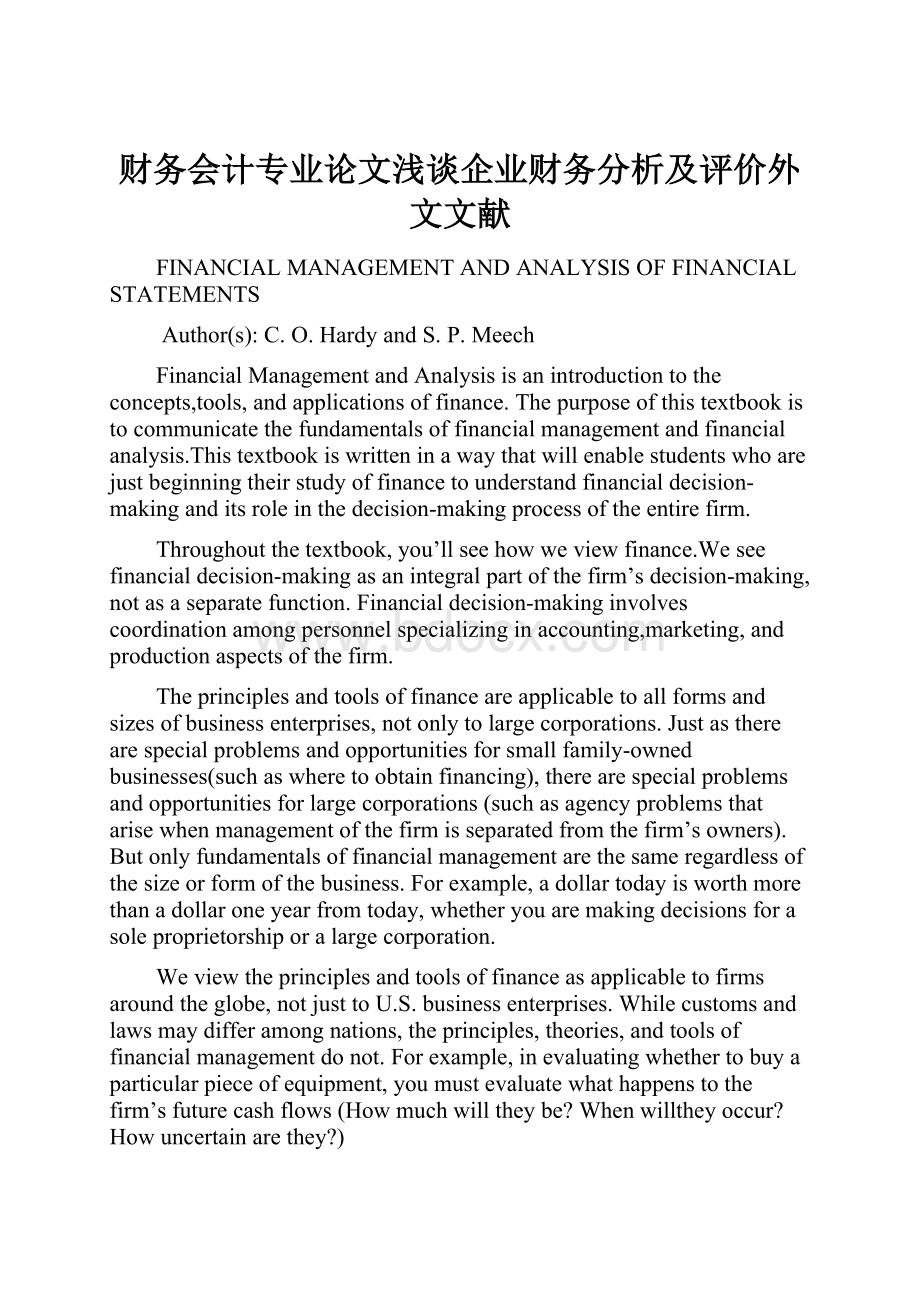财务会计专业论文浅谈企业财务分析及评价外文文献.docx
《财务会计专业论文浅谈企业财务分析及评价外文文献.docx》由会员分享,可在线阅读,更多相关《财务会计专业论文浅谈企业财务分析及评价外文文献.docx(23页珍藏版)》请在冰豆网上搜索。

财务会计专业论文浅谈企业财务分析及评价外文文献
FINANCIALMANAGEMENTANDANALYSISOFFINANCIALSTATEMENTS
Author(s):
C.O.HardyandS.P.Meech
FinancialManagementandAnalysisisanintroductiontotheconcepts,tools,andapplicationsoffinance.Thepurposeofthistextbookistocommunicatethefundamentalsoffinancialmanagementandfinancialanalysis.Thistextbookiswritteninawaythatwillenablestudentswhoarejustbeginningtheirstudyoffinancetounderstandfinancialdecision-makinganditsroleinthedecision-makingprocessoftheentirefirm.
Throughoutthetextbook,you’llseehowweviewfinance.Weseefinancialdecision-makingasanintegralpartofthefirm’sdecision-making,notasaseparatefunction.Financialdecision-makinginvolvescoordinationamongpersonnelspecializinginaccounting,marketing,andproductionaspectsofthefirm.
Theprinciplesandtoolsoffinanceareapplicabletoallformsandsizesofbusinessenterprises,notonlytolargecorporations.Justastherearespecialproblemsandopportunitiesforsmallfamily-ownedbusinesses(suchaswheretoobtainfinancing),therearespecialproblemsandopportunitiesforlargecorporations(suchasagencyproblemsthatarisewhenmanagementofthefirmisseparatedfromthefirm’sowners).Butonlyfundamentalsoffinancialmanagementarethesameregardlessofthesizeorformofthebusiness.Forexample,adollartodayisworthmorethanadollaroneyearfromtoday,whetheryouaremakingdecisionsforasoleproprietorshiporalargecorporation.
Weviewtheprinciplesandtoolsoffinanceasapplicabletofirmsaroundtheglobe,notjusttoU.S.businessenterprises.Whilecustomsandlawsmaydifferamongnations,theprinciples,theories,andtoolsoffinancialmanagementdonot.Forexample,inevaluatingwhethertobuyaparticularpieceofequipment,youmustevaluatewhathappenstothefirm’sfuturecashflows(Howmuchwilltheybe?
Whenwilltheyoccur?
Howuncertainarethey?
)
whetherthefirmislocatedintheUnitedStates,GreatBritain,orelsewhere.Inaddition,webelievethatastrongfoundationinfinanceprinciplesandtherelatedmathematicaltoolsarenecessaryforyoutounderstandhowinvestingandfinancingdecisionsaremade.Butbuildingthatfoundationneednotbestrenuous.Onewaythatwetrytohelpyoubuildthatfoundationistopresenttheprinciplesandtheoriesoffinanceusingintuition,insteadofwithproofsandtheorems.Forexample,wewalkyouthroughtheintuitionofcapitalstructuretheorywithnumericalandrealworldexamples,notequationsandproofs.Anotherwetrytoassistyouistoapproachthetoolsoffinanceusingcareful,step-by-stepexamplesandnumerousgraphs.
FinancialManagementandAnalysisispresentedinsevenparts.Thefirsttwoparts(PartsOneandTwo)coverthebasics,includingtheobjectiveoffinancialmanagement,valuationprinciples,andtherelationbetweenriskandreturn.Financialdecision-makingiscoveredinPartsThree,Four,andFivewherewepresentlong-terminvestmentmanagement(commonlyreferredtoascapitalbudgeting),themanagementoflong-termsourcesoffunds,andworkingcapitalmanagement.PartSixcoversfinancialstatementanalysiswhichincludesfinancialratioanalysis,earningsanalysis,andcashflowanalysis.Thelastpart(PartSeven)coversseveralspecializedtopics:
internationalfinancialmanagement,borrowingviastructuredfinancialtransactions(i.e.,assetsecuritization),projectfinancing,equipmentleasing,andfinancialplanningandstrategy.
Logicalstructure,Thetextbeginswiththebasicprinciplesandtools,followedbylong-terminvestmentandfinancingdecisions.Thefirsttwopartslayoutthebasics;PartThreethenfocusesonthe“leftside”ofthebalancesheet(theassets)andthePartFouristhe“rightside”ofthebalancesheet(theliabilitiesandequity).Workingcapitaldecisions,whicharemadetosupporttheday-to-dayoperationsofthefirm,arediscussedinPartFive.PartSixprovidesthetoolsforanalyzingafirm’sfinancialstatements.Inthelastchapterofthebook,youarebroughtbackfull-circletotheobjectiveoffinancialmanagement:
themaximizationofowners’wealth.
Graphicalillustrations,Graphsandillustrationshavebeencarefullyanddeliberatelydevelopedtodepictandprovidevisualreinforcementofmathematicalconcepts.Forexample,weshowthegrowthofabankbalancethroughcompoundinterestseveralways:
mathematically,inatime-line,andwithabargraph.
Applications,Asmuchaspossible,wedevelopconceptsandmathematicsusingexamplesofactualpractice.Forexample,wefirstpresentfinancialanalysisusingasimplifiedsetoffinancialstatementsforafictitiouscompany.Afteryou’velearnedthebasicsusingthefictitiouscompany,wedemonstratefinancialanalysistoolsusingdatafromWal-MartStores,Inc.Actualexampleshelpyoubettergraspandretainmajorconceptsandtools.Weintegrateover100actualcompanyexamplesthroughoutthetext,soyou’renotapttomissthem.Consideringboththeexamplesthroughoutthetextandtheresearchquestionsandproblems,youareexposedtohundredsofactualcompanies.
Extensivecoverageoffinancialstatementanalysis.Whilemosttextbooksprovidesomecoverageoffinancialstatementanalysis,wehaveprovidedyouwithmuchmoredetailinPartSixofthetextbook.Chapter6andthethreechaptersinPartSixallowaninstructortofocusonfinancialstatementanalysis.
Extensivecoverageofalternativedebtinstruments.Becauseoftheinnovationsinthedebtmarket,alternativeformsdebtinstrumentscanbeissuedbyacorporation.InChapter15,youareintroducedtotheseinstruments.Wethendevoteonechaptertothemostpopularalternativetocorporatebondissuance,thecreationandissuanceofasset-backedsecurities.
Coverageofleasingandprojectfinancing.Weprovidein-depthcoverageofleasinginChapter27,demystifyingtheclaimsabouttheadvantagesanddisadvantagesofleasingyoutoooftenreadaboutinsometextbooksandprofessionalarticles.Projectfinancinghasgrowninimportancefornotonlycorporationsbutforcountriesseekingtodevelopinfrastructurefacilities.Chapter28providesthebasicprinciplesforunderstandingprojectfinancing.
Earlyintroductiontoderivativeinstruments.Derivativeinstruments(futures,swaps,andoptions)playanimportantroleinfinance.YouareintroducedtotheseinstrumentsinChapter4.Whilederivativeinstrumentsareviewedascomplexinstruments,youareprovidedwithanintroductionthatmakescleartheirbasicinvestmentcharacteristics.Bytheearlyintroductionofderivativeinstruments,youwillbeabletoappreciatethedifficultiesofevaluatingsecuritiesthathaveembeddedoptions(Chapter9),howtherearerealoptionsembeddedincapitalbudgetingdecisions(Chapter14),andhowderivativeinstrumentscanbeusedtoreduceortohedgethecostofborrowing(Chapter15).Stand-alonenatureofthechapters.Eachchapteriswrittensothatchaptersmayeasilyberearrangedtofitdifferentcoursestructures.Concepts,terminology,andnotationarepresentedineachchaptersothatnochapterisdependentuponanother.Thismeansthatinstructorscantailortheuseofthisbooktofittheirparticulartimeframeforthecourseandtheirstudents’preparation(forexample,ifstudentsenterthecoursewithsufficientbackgroundinaccountingandtaxation,Chapters5and6canbeskipped).Webelievethatourapproachtothesubjectmatteroffinancialmanagementandanalysiswillhelpyouunderstandthekeyissuesandprovidethefoundationfordevelopingaskillsetnecessarytodealwithrealworldfinancialproblems.
IntroductiontoFinancialManagementandAnalysis
Financeistheapplicationofeconomicprinciplesandconceptstobusinessdecision-makingandproblemsolving.Thefieldoffinancecanbeconsideredtocomprisethreebroadcategories:
financialmanagement,investments,andfinancialinstitutions:
Financialmanagement.Sometimescalledcorporatefinanceorbusinessfinance,thisareaoffinanceisconcernedprimarilywithfinancialdecision-makingwithinabusinessentity.Financialmanagementdecisionsincludemaintainingcashbalances,extendingcredit,acquiringotherfirms,borrowingfrombanks,andissuingstocksandbonds.
Investments,Thisareaoffinancefocusesonthebehavioroffinancialmarketsandthepricingofsecurities.Aninvestmentmanager’stasks,forexample,mayincludevaluingcommonstocks,selectingsecuritiesforapensionfund,ormeasuringaportfolio’sperformance.
Financialinstitutions,Thisareaoffinancedealswithbanksandotherfirmsthatspecializeinbringingthesuppliersoffundstogetherwiththeusersoffunds.Forexample,amanagerofabankmaymakedecisionsregardinggrantingloans,managingcashbalances,settinginterestratesonloans,anddealingwithgovernmentregulations.Nomattertheparticularcategoryoffinance,businesssituationsthatcallfortheapplicationofthetheoriesandtoolsoffinancegenerallyinvolveeitherinvesting(usingfunds)orfinancing(raisingfunds).
Managerswhoworkinanyofthesethreeareasrelyonthesamebasicknowledgeoffinance.Inthisbook,weintroduceyoutothiscommonbodyofknowledgeandshowhowitisusedinfinancialdecision-making.Thoughtheemphasisofthisbookisfinancialmanagement,thebasicprinciplesandtoolsalsoapplytotheareasofinvestmentsandfinancialinstitutions.Inthisintroductorychapter,we’llconsiderthetypesofdecisionsfinancialmanagersmake,theroleoffinancialanalysis,theformsofbusinessownership,andtheobjectiveofmanagers’decisions.Finally,wewilldescribetherelationshipbetweenownersandmanagers.
FINANCIALMANAGEMENT
Financi